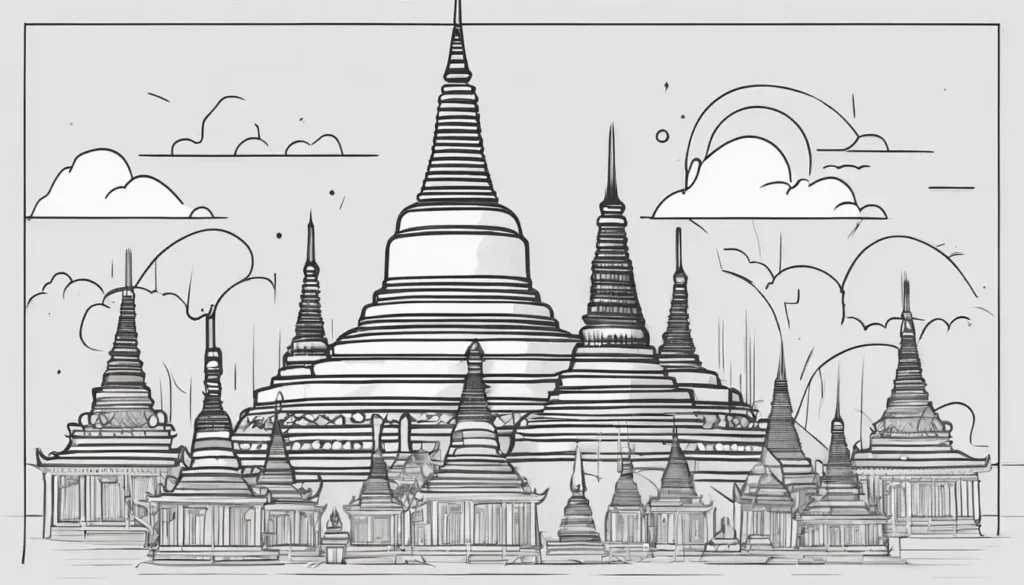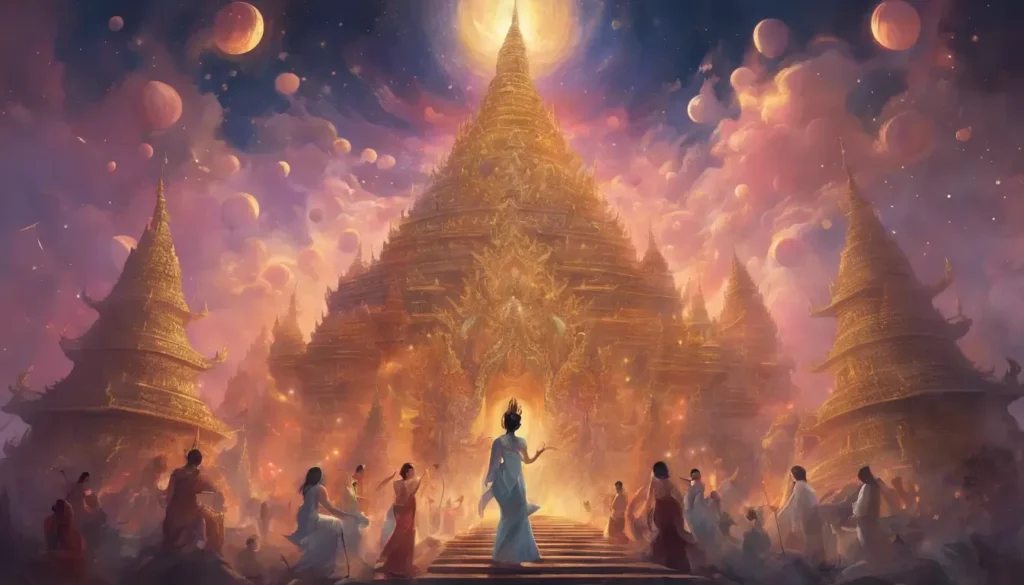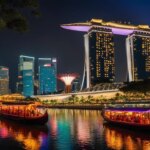The Thadingyut Festival, also known as the Festival of Lights, is in the city of Mandalay, Myanmar. This Burmese tradition marks the end of Buddhist Lent and is a time of joyous festivities and religious observances. During this October full moon period, the streets come alive with the glow of countless candles, as people participate in street fairs, make religious offerings, and visit pagodas to pay their respects to the Buddhist culture and traditions.
One of the most captivating aspects of the Thadingyut Festival is the beautiful light displays that adorn the city, creating a mesmerizing atmosphere that honors elders and promotes spiritual gatherings and community events.
As a public holiday in Myanmar, this celebration invites you to partake in cultural events and experience the warmth and hospitality of the people of Mandalay.
Key Takeaways:
- Thadingyut Festival: The Thadingyut Festival, also known as the Festival of Lights, is a major Burmese celebration that marks the end of Buddhist Lent.
- Mandalay, Myanmar: The festival is widely celebrated in Mandalay, Myanmar, with various cultural events, street fairs, and religious offerings taking place throughout the city.
- Buddhist Culture and Traditions: During Thadingyut, people honour their elders, light candles, visit pagodas, and participate in community events that reflect the spiritual and communal aspects of Burmese Buddhist culture.
Facts About The Thadingyut Festival of Lights Mandalay Myanmar
| Facts | Explanation |
|---|---|
| Name of the festival | Thadingyut Festival |
| Type of festival | Cultural, religious |
| City of origin | Yangon |
| Festival Etymology | Thadingyut derives from the Pali term “Thadingyut Pavarana,” meaning the end of Buddhist Lent. |
| Date when it was celebrated first | Unknown (traditional festival) |
| Founder of the Festival | Unknown (traditional festival) |
| Brief history of the festival | Thadingyut Festival is an important celebration in Myanmar, marking the end of the Buddhist Lent period. It is a time when people pay homage to their ancestors and offer donations to monks. The festival involves illuminated decorations, pagoda visits, and joyful gatherings. It is believed that during this time, Gautama Buddha descended from heaven after spending three months teaching and preaching to his mother. The festival is an occasion for spiritual reflection, gratitude, and acts of merit. |
| Brief history of the city | Yangon, formerly known as Rangoon, is Myanmar’s largest city and commercial center. It has a rich history dating back to the 11th century. Over the centuries, Yangon has been influenced by various civilizations, including the Mon, British colonial rule, and Japanese occupation during World War II. The city served as the capital of Myanmar until 2006 when the government moved it to Naypyidaw. Today, Yangon is a vibrant city with a mix of colonial architecture, bustling markets, and religious landmarks. |
| Ethnic information | Yangon is home to a diverse population comprising various ethnic groups, including the Bamar (majority), Mon, Rakhine, Shan, Chinese, and Indian communities. |
| Location of the city in the country | Yangon is located in the southern part of Myanmar (formerly Burma). |
| How to reach the city | Yangon can be reached by international flights to Yangon International Airport or by land via neighboring countries. Domestic flights and buses are available from other cities within Myanmar. |
| Nearby and surrounding cities or towns | – Bago: 80 km north of Yangon – Thanlyin: 17 km southeast of Yangon – Twante: 24 km west of Yangon – Dala: Located across the Yangon River from Yangon City – Dagon Myothit: A satellite town in the Yangon Metropolitan Area – Hlaing Tharyar: A satellite town in the Yangon Metropolitan Area – Mingaladon: Located near Yangon International Airport – Tamwe: A township in eastern Yangon – Insein: A township in northern Yangon – Mayangone: A township in northeastern Yangon |
| Google map link to city location | Yangon City Location |
| Festival main events and activities | – Illuminated pagodas and temples – Offering donations to monks – Candlelight processions – Fireworks displays – Traditional music and dance performances – Street fairs and food stalls |
| Other famous tourist attractions in the city | – Shwedagon Pagoda: One of Myanmar’s most sacred Buddhist sites – Sule Pagoda: A historic pagoda located in downtown Yangon – Bogyoke Aung San Market: A bustling market known for its handicrafts and gems – Chaukhtatgyi Pagoda: Home to a colossal reclining Buddha statue – National Museum of Myanmar: Showcasing the country’s rich cultural heritage |
| Famous food dishes of the city | – Mohinga: A traditional Burmese fish noodle soup – Tea leaf salad (Laphet Thoke): Made with fermented tea leaves, nuts, and various ingredients – Shan-style noodles: Rice noodles served with meat and vegetable toppings – Burmese curry: Flavorful curries made with local spices and ingredients – Samosas: Deep-fried pastries filled with savoury ingredients |
| Landmarks in the city | – Shwedagon Pagoda: Iconic golden pagoda visible from many parts of the city – Sule Pagoda: Historic landmark at the heart of downtown Yangon – Yangon Circular Train: A scenic train ride around the city outskirts – Botataung Pagoda: Known for its ancient relics and riverside location – Kandawgyi Lake: A peaceful lake with a beautiful view of the Shwedagon Pagoda |
| One line about why they are famous | Shwedagon Pagoda is famous for its towering golden stupa, while Sule Pagoda holds historical significance as a central landmark. The Yangon Circular Train offers a unique way to explore the city’s outskirts, and Botataung Pagoda is renowned for its sacred relics. Kandawgyi Lake provides a tranquil escape with stunning views of the Shwedagon Pagoda. |
| Related festivals in the same region | – Thingyan Water Festival (Myanmar New Year): Celebrated in April, it marks the Burmese New Year with water-throwing festivities and merit-making activities – Kachin Manao Festival: Celebrated by the Kachin ethnic group, featuring traditional dances, music, and sports competitions – Naga New Year Festival: Celebrated by the Naga people with cultural performances, feasting, and traditional rituals – Pindaya Cave Festival: Held near Pindaya Cave, featuring colorful processions and traditional performances |
Historical Context of Thadingyut Festival

Understanding the historical context of the Thadingyut Festival is crucial to appreciating the significance of this Burmese celebration. The festival is also known as the “Festival of Lights,” and it marks the end of Buddhist Lent in Myanmar. It is a time of joy and spiritual reflection, and the festivities showcase the rich cultural heritage of the country.
Origin and the End of Buddhist Lent
The Thadingyut Festival takes place on the full moon day of Thadingyut, which usually falls around October. This marks the end of the three-month Buddhist Lent period, during which monks traditionally retreat to their monasteries for intensive meditation and study. As the Lent period concludes, the entire community comes together to celebrate the return of the monks and to make merit through various religious offerings.
Thadingyut Through the Ages
Throughout history, the Thadingyut Festival has been an integral part of Myanmar’s cultural and religious traditions. The festival’s origins can be traced back to ancient times, and it has evolved over the ages to encompass a wide range of customs and practices. From the lighting of candles and oil lamps to the elaborate street fairs and pagoda visits, Thadingyut has remained a cherished part of Burmese culture.
Spiritual Significance and Religious Practices
Some of the key spiritual significance and religious practices associated with the Thadingyut Festival of Lights in Mandalay, Myanmar revolve around the end of Buddhist Lent and the lighting of candles. This festival is a significant time for Burmese people to honour their elders, make religious offerings, and celebrate the arrival of the October full moon, which holds special significance in Myanmar’s Buddhist culture.
Lighting of Candles and Their Symbolism
The lighting of candles during the Thadingyut Festival symbolizes the illumination of knowledge and the dispelling of darkness, both in a literal and metaphorical sense.
You will find streets, homes, and religious sites adorned with thousands of flickering candles, creating a serene and mystical atmosphere. This act not only signifies the end of Buddhist Lent but also serves as a form of spiritual enlightenment and purification.
Pagoda Visits and Making Merit
During the Thadingyut festivities, visiting pagodas to make merit is a common practice. This involves offering food, flowers, and other symbolic items at the pagodas as a way of earning spiritual credits and accumulating good karma.
You will witness devout Buddhists dressing in their finest traditional attire and participating in religious rituals at the pagodas, creating a deeply spiritual and communal atmosphere. Pagoda visits are a vital part of the festival, and they offer a unique insight into the religious devotion and cultural traditions of Myanmar.
Thadingyut Festival in Mandalay
For the people of Mandalay, the Thadingyut Festival is a time of great celebration and reverence. This festival, also known as the Festival of Lights, marks the end of Buddhist Lent and is a time for communities to come together to honour their spiritual beliefs and culture.
The month of Thadingyut, which falls in October, is particularly significant as it coincides with the full moon, making it an especially auspicious time for religious and cultural festivities.
Unique Traditions in Mandalay
One of the unique traditions observed during the Thadingyut Festival in Mandalay is the practice of honouring elders. It is a time for families to show their respect and gratitude to the older generation, often with offerings of food and gifts. This tradition reflects the importance of filial piety and the deep-rooted values of respect and gratitude within the Burmese culture.
Additionally, Mandalay is known for its elaborate light displays during the festival, with streets lined with illuminated lanterns and decorations, creating a breathtaking spectacle that symbolizes the triumph of light over darkness.
Key Locations for Festival Activities
During the Thadingyut Festival, Mandalay comes alive with vibrant street fairs and religious offerings as the city’s residents take part in various activities to mark the occasion. Pagoda visits are an integral part of the festival, with many people flocking to the sacred sites to make offerings and pray.
The Mahamuni Pagoda, famous for its revered Buddha statue, is a particularly popular destination during the festival. You will also find an array of cultural events and spiritual gatherings taking place throughout the city, providing a fascinating insight into the rich traditions and customs of Mandalay during this time of celebration.
Celebratory Events and Street Fairs
Keep your eyes open for the vibrant street fairs and celebratory events that take place during the Thadingyut Festival. The streets of Mandalay come alive with colourful decorations, music, and a lively atmosphere as locals and visitors gather to celebrate the end of Buddhist Lent. You can immerse yourself in the festive spirit by taking part in the various activities and enjoying the traditional Burmese cuisine on offer.
Overview of Festivities
During the Thadingyut Festival, Mandalay becomes a hub of excitement and cultural celebration. The festival marks the end of Buddhist Lent, and the entire city is illuminated with the soft glow of candles and decorative lights. It is a time for spiritual gatherings and community events, as people come together to pay their respects to elders and make religious offerings at pagodas.
This is a deeply rooted part of Burmese culture, and you will have the opportunity to witness the customs and traditions that have been passed down through generations.
Cultural Performances and Vendors
As you wander through the bustling streets of Mandalay during the Thadingyut Festival, you will be treated to a feast for the senses. Cultural performances, including traditional dance and music, take place throughout the city. Local artisans and vendors set up stalls selling handmade crafts, artwork, and delicious street food.
You can browse through the vibrant displays, taste the local delicacies, and take home unique souvenirs as mementos of your time at the festival.
Community and Family Traditions
After the Thadingyut Festival of Lights in Mandalay, Myanmar, the celebration continues with community and family traditions that highlight the spirit of togetherness and reverence for elders. These traditions play a crucial role in strengthening family bonds and fostering a sense of community among the people of Myanmar.
Honouring Elders Ceremony
During the Thadingyut Festival, one of the most cherished traditions is the Honoring Elders Ceremony. This ceremony serves as a way to show respect and appreciation for the wisdom and guidance provided by the elder members of the community.
As a part of this ceremony, families gather to pay their respects to their elders, presenting them with offerings as a symbol of gratitude for their love, care, and invaluable teachings. It is a truly heartwarming experience to witness the younger generation expressing their admiration and reverence for the elders in their community.
Community Gatherings and Bonding
Thadingyut Festival provides a wonderful opportunity for community gatherings and bonding. It is a time when neighbourhoods come together to organize various events and activities, such as communal feasts, traditional performances, and friendly competitions.
These gatherings foster a sense of unity and belonging among the residents, allowing them to connect and strengthen their social ties. Additionally, they create a warm and inclusive atmosphere that enriches the festival experience and leaves a lasting impression on all those who participate.
Light Displays and Decorations
Now let’s talk about the captivating light displays and decorations that adorn the streets and homes during the Thadingyut Festival in Mandalay, Myanmar. The festival is a visual spectacle with a myriad of lights, colours, and decorations that add to the festive atmosphere.
Public and Private Light Displays
During Thadingyut, the streets of Mandalay come alive with an array of public light displays. From intricate patterns of twinkling fairy lights to elaborate LED designs, the city is transformed into a mesmerizing wonderland. You will find streets adorned with colourful lanterns, creating an enchanting ambience that is truly breathtaking.
Private homes also participate in the festivities by adorning their properties with illuminated decorations, creating a warm and inviting atmosphere for visitors and passersby.
Creativity in Illumination Techniques
The creativity in illumination techniques during the Thadingyut Festival is truly a sight to behold. Artisans and craftsmen showcase their skills through the use of various lighting techniques, including intricate paper lanterns, traditional oil lamps, and modern LED installations.
Each display is a testament to the ingenuity and artistry of the local community, with some displays depicting traditional Burmese motifs and others reflecting contemporary themes. You will be fascinated by the level of detail and skill that goes into creating these stunning displays, which add to the festive spirit of the Thadingyut celebrations.
Whether it’s the vibrant glow of a homemade lantern or the elaborate light installations at public venues, the creativity in illumination techniques is an integral part of the festival’s charm.
Impact of Thadingyut Festival on Burmese Society
Not only is the Thadingyut Festival a significant religious event in Myanmar, but it also plays a crucial role in shaping Burmese society and culture. The festival’s impact extends beyond the religious sphere, influencing various aspects of daily life and community dynamics in Myanmar.
Thadingyut as a Public Holiday
Thadingyut holds the status of a Burmese public holiday, contributing to the festival’s impact on society. As a result, the entire nation comes to a standstill as people take time off from work and engage in festive activities.
This creates a sense of unity and togetherness, as people come together to celebrate and honour their traditions. The public holiday also allows for family gatherings and fosters a sense of community, strengthening social bonds and promoting a spirit of solidarity among the people of Myanmar.
Promotion of Burmese Culture and Tourism
The Thadingyut Festival serves as a platform for the promotion of Burmese culture and tourism, both domestically and internationally. The vibrant and colourful celebrations during the festival showcase the rich tapestry of Burmese traditions, offering a window into the cultural heritage of the country.
This exposure not only preserves the cultural identity of Myanmar but also piques the interest of tourists and visitors, drawing attention to the unique customs and practices of the nation. As a result, the festival contributes to the growth of tourism in Myanmar, bringing economic benefits and opportunities for the local communities.
Summing up the Thadingyut Festival of Lights in Mandalay, Myanmar
The Thadingyut Festival, also known as the Festival of Lights, is a vibrant and significant Burmese celebration that marks the end of Buddhist Lent. During this time, the streets come alive with the glow of candles and colourful light displays, as people visit pagodas to make religious offerings and honour their elders. This festival, which takes place on the October full moon, is a time for spiritual gatherings, community events, and celebrations of Myanmar traditions and Buddhist culture. It is a time for joy, gratitude, and coming together as a community.
If you ever have the chance to visit Mandalay during the Thadingyut festivities, you will have the opportunity to experience the beauty and warmth of Burmese cultural events. You will be able to witness the lighting of candles, participate in street fairs, and immerse yourself in the rich spiritual and communal aspects of the festival.
The Thadingyut Festival is not only a Burmese public holiday, but also an extraordinary experience that will leave you with a deep appreciation for the traditions and values of Myanmar.
Surprising Facts About Thadingyut Festival Myanmar
- 🌕 Thadingyut Festival, also known as the Lighting Festival, is celebrated in Myanmar during the full moon day of the Burmese lunar month of Thadingyut (September-October).
- 🏮 While many associate Thadingyut with lighting traditional oil lamps, one unique feature is the use of colourful paper lanterns shaped like various animals and mythical creatures, creating a magical atmosphere.
- 🎉 Thadingyut marks the end of the Buddhist Lent, three months during which monks traditionally stay in their monasteries for intensive meditation and study.
- 🕯️ In addition to lighting candles and lamps at homes and pagodas, some devotees engage in a practice called “Kahtein,” where they offer new robes and other necessities to monks as a form of merit-making.
- 🎶 The festival is not just about visual delights; it also involves music and dance performances. Traditional Burmese music, accompanied by elaborate dance routines, adds vibrancy to the celebrations.
- 🏞️ Thadingyut is an occasion for family reunions, and it is common for people to visit their elders and seek forgiveness for any wrongdoings as a gesture of respect.
- 🎊 Gambling is traditionally prohibited during Thadingyut as it is considered an inappropriate way to celebrate the end of Buddhist Lent. Instead, people focus on positive and wholesome activities.
- 🚶♂️ A distinctive custom during Thadingyut involves paying homage to one’s parents by presenting them with gifts and expressing gratitude for their love and care.
- 🍬 Sweet treats play a significant role in Thadingyut celebrations, with families sharing traditional Burmese sweets and delicacies with neighbours and friends.
- 🌳 In some regions, people also participate in tree-planting ceremonies during Thadingyut as a symbolic gesture of promoting environmental sustainability and harmony with nature.
Frequently Asked Questions
Q: What is the Thadingyut Festival?
A: The Thadingyut Festival, also known as the Festival of Lights, is a Burmese celebration that marks the end of Buddhist Lent. It is a time when people decorate their homes and streets with candles and lanterns and participate in various religious and cultural activities to honour the Buddha and show gratitude to their elders.
Q: When and where does the Thadingyut Festival take place?
A: The Thadingyut Festival is celebrated on the full moon day of the Burmese lunar month of Thadingyut, which usually falls in October. In Mandalay, Myanmar, the festival is marked by street fairs, visits to pagodas, and various cultural events that showcase the traditional customs and values of the Burmese people.
Q: What are the main activities and traditions associated with the Thadingyut Festival?
A: During the Thadingyut Festival, people engage in lighting candles and offering religious donations at pagodas, as well as participating in light displays and community events. It is a time for spiritual gatherings, honouring elders, and strengthening the bonds within the community. The festival is also a public holiday in Myanmar, allowing people to come together and celebrate their shared cultural heritage.



